Wanting to know how to grow rhubarb? Rhubarb is very easy to grow, but needs the cold weather in order to propagate. It is a long-lived perennial vegetable that is ready for harvest in early spring.
In fact, there are rhubarb plants that have been alive since the 1950’s, so taking excellent care means it may outlive the gardener, making it an excellent perennial to invest in. There are many wonderful rhubarb recipes. It is delicious when used for making jellies, pies, and sauces, especially when paired with strawberries!
If you would like to learn how to care for rhubarb in your garden, here are some tips for rhubarb care to get you started.
Table of Contents
Is Rhubarb Poisonous?
Of all the parts of rhubarb, only the stalk is safe to eat. It has a rich, tart flavor. Eating rhubarb leaves, however, can be poisonous. Be careful to cut the leaves off and throw them away as soon as you harvest the stalks so that neither human or pet can accidentally eat them.
Is Rhubarb a Fruit or a Vegetable?
Wondering if rhubarb is a vegetable is a very common question. Rhubarb is one of the most popular of the perennial vegetables since it is often used with fruit in different kinds of desserts and can be made into jam. It can also be used in omelettes, soups, and other savory dishes.
What Does Rhubarb Look Like?
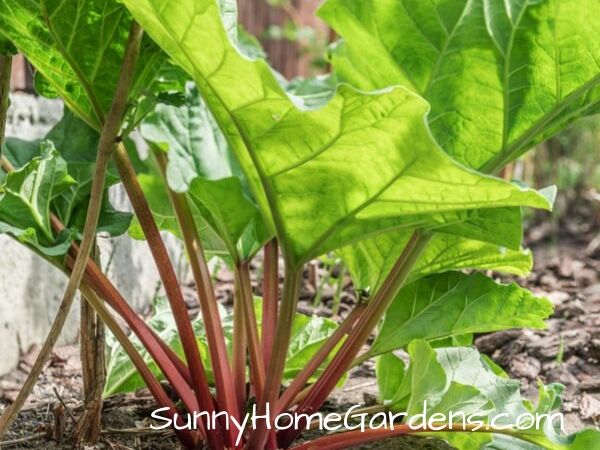
Rhubarb has long red stalks that tend to change to green near the top of the stalk where large green leaves grow.
What’s The Right Temperature?
Rhubarb thrives best when it overwinters in soil that is 40 degrees Fahrenheit or below. It produces best in temperatures of 75 degrees Fahrenheit or less in the warmer months.
Rhubarb Soil Requirements
Since rhubarb is a perennial vegetable, its care is a little different when compared to the care of other vegetables.
Planting it along the edges of your garden, away from other vegetables is a good ideas so you don’t disturb the rhubarb plants during the harvesting season. Since it is a perennial you don’t want to accidentally break the rhubarb roots or uproot it when harvesting nearby plants.
When choosing a spot in your garden, make sure the soil is well draining and fertile. The soil should also have a pH of 5.5 to 6.5. Before planting rhubarb, be sure to eliminate all the weeds from the area, it doesn’t compete well with weeds.
Rhubarb can tolerate some shade, but to get the best yields and harvests, they need to be in full sun, with consistent and plentiful moisture.
Best Rhubarb Variety to Grow
If you decide to plant rhubarb in your garden, there are a lot of varieties to choose from.
Here are some of the favorites, that can be planted in the spring or in autumn:
Delight
Delight is an overbearing variety that is distinct for its dark green and red stems, and its lovely flavor. It grows for a long period and has good disease resistance.
Zones: 4 – 7
Champagne
Champagne is an easy to grow and a reliable technique.
Rather than a variety, this one is an actual technique where it is forced to grow very early in the season. Grown under lights this process makes the rhubarb more delicate and lighter in color than normal.
It can produce slender, long, and pink tinged stalks that change to a deeper red stem.
Fulton’s Strawberry Surprise
These vigorous, strong plants produce vivid, eye-catching red stems that when cooked, have a well-balanced acidity. In fact, according to the RHS Wisley plant trials, it is considered one of the best flavored of the rhubarb varieties.
Zones: 7 – 9
Giant Grooveless Crimson
Unlike other rhubarb, the Giant Grooveless Crimson produces a bountiful supply of uniform, tall, and fully colored bright red stems with a delicate, acidic flavor.
Zones: 10 – 11
Victoria
Victoria produces a perfect balance of acidity and sweetness. Once it is fully established in your garden, it produces a heavy crop, year after year, for several years. It grows greenish to pink stems.
Zones: 3-8
Growing Rhubarb from Seed VS Rhubarb Crowns
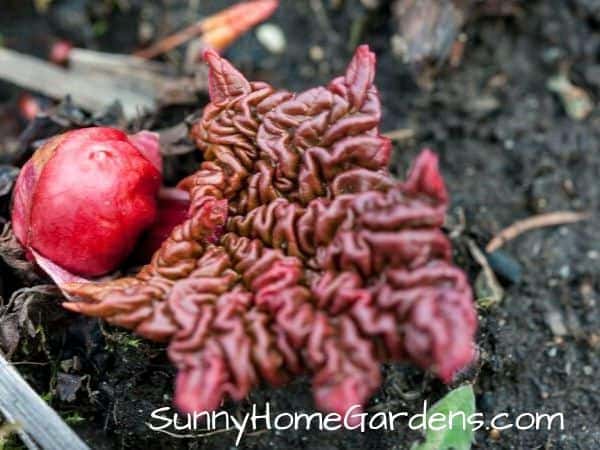
Like other plants in the garden, you can grow these perennials from seeds. However, it is much easier to plant budded pieces or plant crowns as they are already well established, and ideal for beginners.
Plant crowns are already established crops that are at least a year old. Unlike those grown from seeds, they can produce a crop during their first year of harvest after planting because they are at least a year old when planted.
Budded pieces, on the other hand, are a portion of the already established crowns. If you choose to plant them, you can expect to start seeing blooms two years after you plant them.
How To Plant Rhubarb Crowns
Before you start planting your rhubarb, you need to prepare the area chosen. Thoroughly remove the weeds and start by generously mixing well-rotted manure or organic fertilizer into the soil.
If you choose to plant budded pieces or crowns, you’ll need to set them so that the top of the crown sits at least an inch below the soil level. If the soil in your garden is heavy and wet, you would need to plant them slightly higher so that the top of the crown sits on the soil level to avoid rotting.
Since rhubarb can be quite large once they mature, maintain a spacing of at least 30 inches between each plant.
Growing Rhubarb in Pots
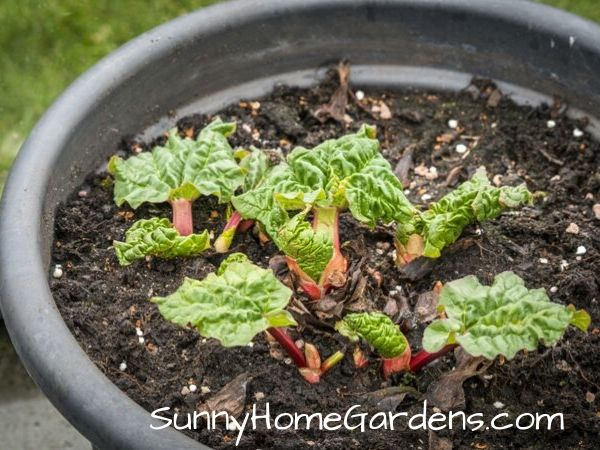
Yes, you can grow rhubarb in pots and containers.
However, since these perennials have big root systems, they also require a decent amount of space in order to grow. If you have limited space in your garden, you need to use a pot that can hold at least 10 gallons of compost and soil mix to produce a decent crop.
Rhubarb Fertilizer
Rhubarb needs constant moisture, but they don’t like soggy and overwatered soil.
To maintain consistent moisture in your garden, you can use an irrigation system.
During the plant’s second spring, apply one half cup of 10-10-10 fertilizer around the plants at about 6 inches away from the crowns. Do not apply the fertilizer directly to the crowns as it can burn them.
Continue to feed your plants with the same fertilizer once they start to grow until you begin to harvest.
Rhubarb Growing Problems
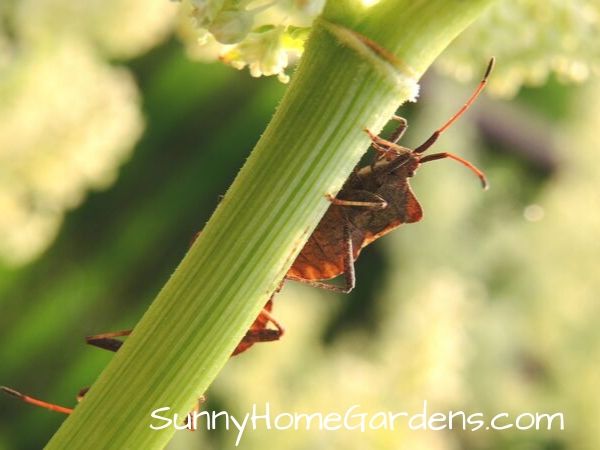
Rhubarb plants are fairly free from pests and diseases. However, you need to keep an eye out for beetles and mites.
These half-inch long beetles and mites will often feed on the stems and leaves of rhubarb plants. You can easily remove the beetles by hand picking them from the plants or sprinkling diatomaceous earth around the soil beneath the plants or throughout the garden beds.
Mites, on the other hand, can be removed by treating the plants with neem oil. Prepare the neem oil solution by mixing 2 to 3 tablespoons of cold pressed neem oil with 2 to 3 tablespoons of mild soap and 1 gallon of water. Transfer the solution to a spray bottle then spray around the plants. The soap allows the oil to mix with the water, so remember to shake the spray bottle about every 30 seconds or so to keep the solution mixed well.
You may also find snails, slugs, and other garden critters that will start to feed on your plants. You can use eggshell barriers or consistently spray the neem oil solution.
When planting rhubarb, you might also encounter fungal leaf rot. This disease happens if the leaves remain wet for a long time or if the plants are too crowded, resulting in poor air circulation.
If you notice this, just carefully remove and dispose of the affected leaves to avoid the spreading of the fungus.
To avoid fungal growth or rotting, make sure that the rhubarb is planted in a well-draining soil. When watering the plants, only water the base of the plants and not the leaves. Watering during the early hours of the morning can help too.
Mulching Rhubarb Plants
Another way to discourage weeds and to retain the moisture in your soil is by mulching.
Apply a generous layer of mulch around the plants. It is ideal to use organic mulch like layers of cow manure, old newspaper, leaves or straw, that not only protects the roots and the stems of your perennials, but also provide more nutrients that it will need as time goes on.
When to Pick Rhubarb?
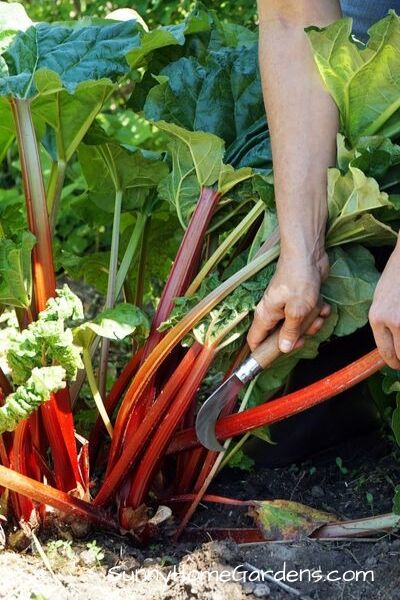
When it is time to harvest the rhubarb, do not remove those with young leaves that you planted during the first year after planting. This will not allow the plant to expand and become established to its fullest.
The best time to harvest rhubarb is during its second year.
Harvest the stalks once they are about 12 to 18 inches long. If you see that the stalks are becoming thin, stop harvesting the plants as it means that the food reserves are lower.
When harvesting your rhubarb, grab the base of the stalk then with a gentle twist, pull them away from the plant. If this does not work, you can cut the stalk from its base with a knife or scissors.
Make sure to leave at least two stalks per plants to ensure that it will continue to grow and reproduce. In fact, you can have a bountiful harvest that can last more than 20 years, without the need of replanting the rhubarb.
Once the harvest time is over, the stems will start to die back. Once this happens, remove all the plant debris. If the ground starts to freeze, cover the rhubarb with two to four inches of mulch. You can also add nitrogen to the soil to prepare your perennials for a good spring and harvesting season.
Rich in dietary fiber and vitamin C, rhubarb is not only delicious with a tangy and sour taste, it is also healthy and can be used in many different dishes.
Planting rhubarb is not complicated. In fact, as long as you know how to start and take care of them, you can expect several years of bountiful harvest from this perennial.
If you found this helpful, please make sure to “PIN IT“!
Other posts you might enjoy reading:
Best Perennial Vegetables for Your Garden
How to Plant and Grow Asparagus
Asparagus Varieties to Add to Your Perennial Garden


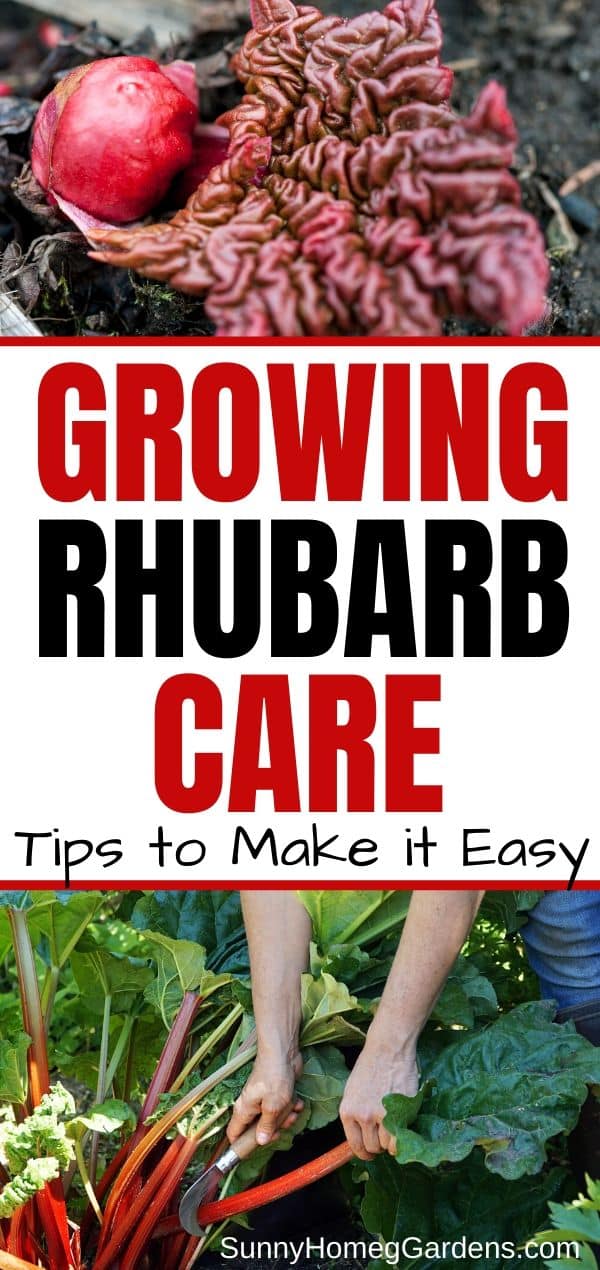
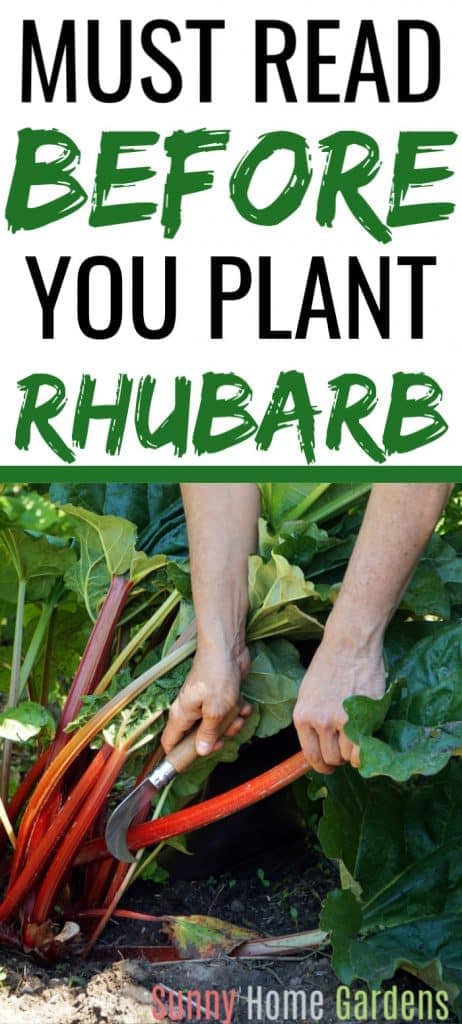
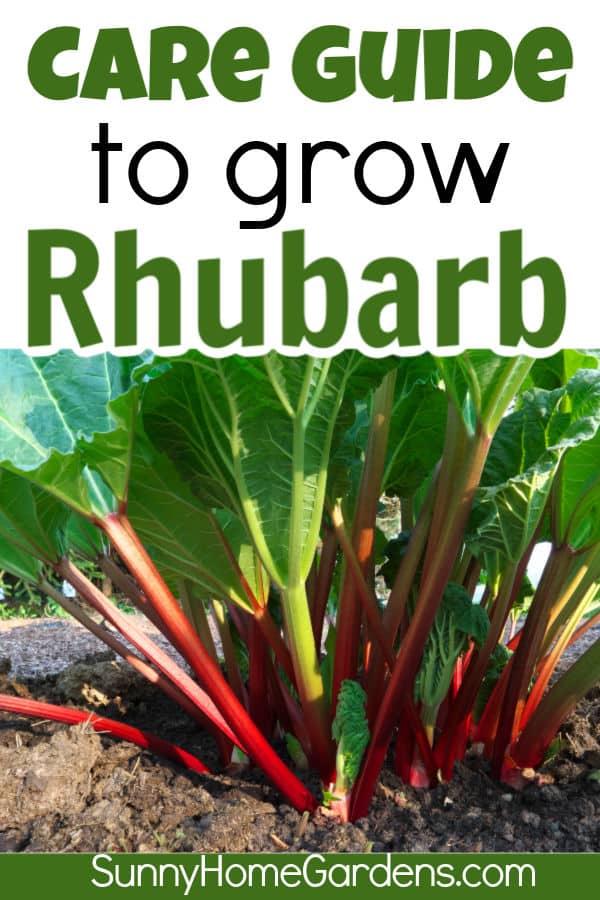
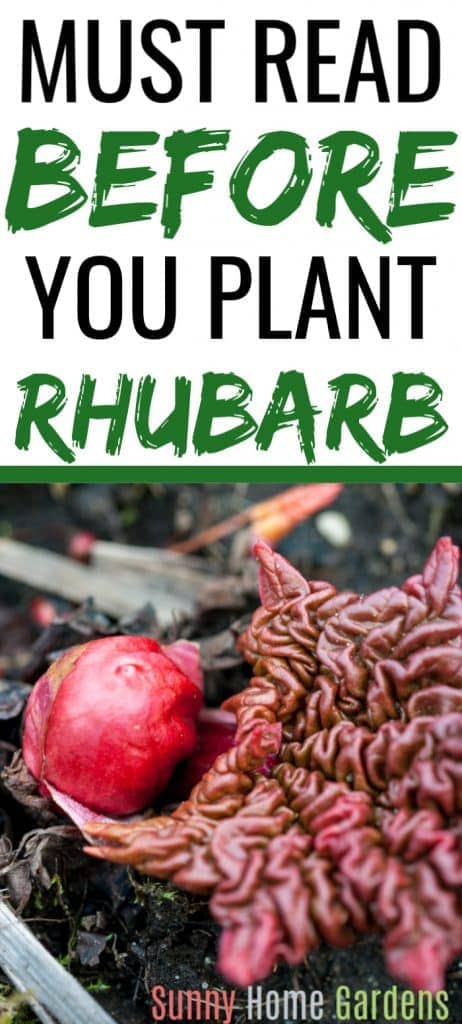
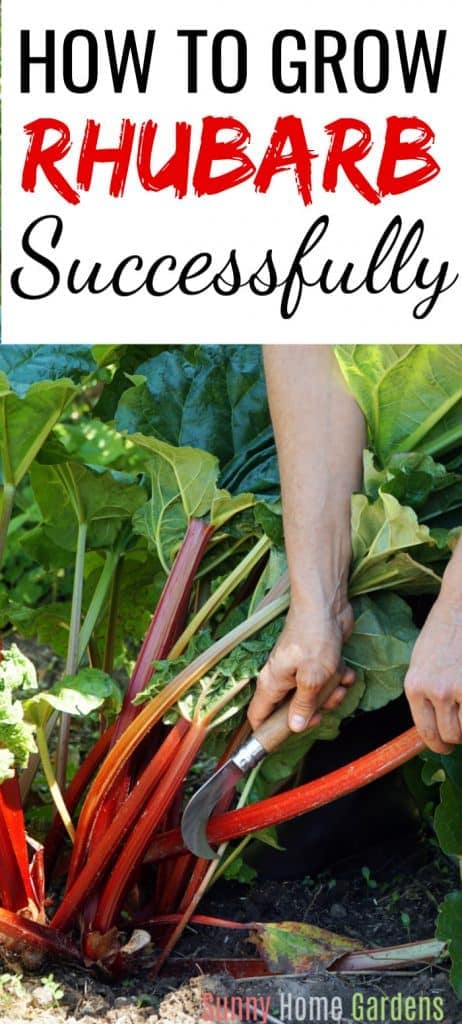
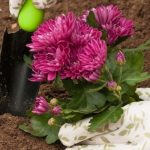
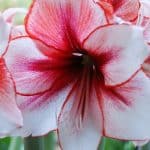
Great info! Thank you. I was hoping to find something that would give me varieties and planting tips. Perfect!